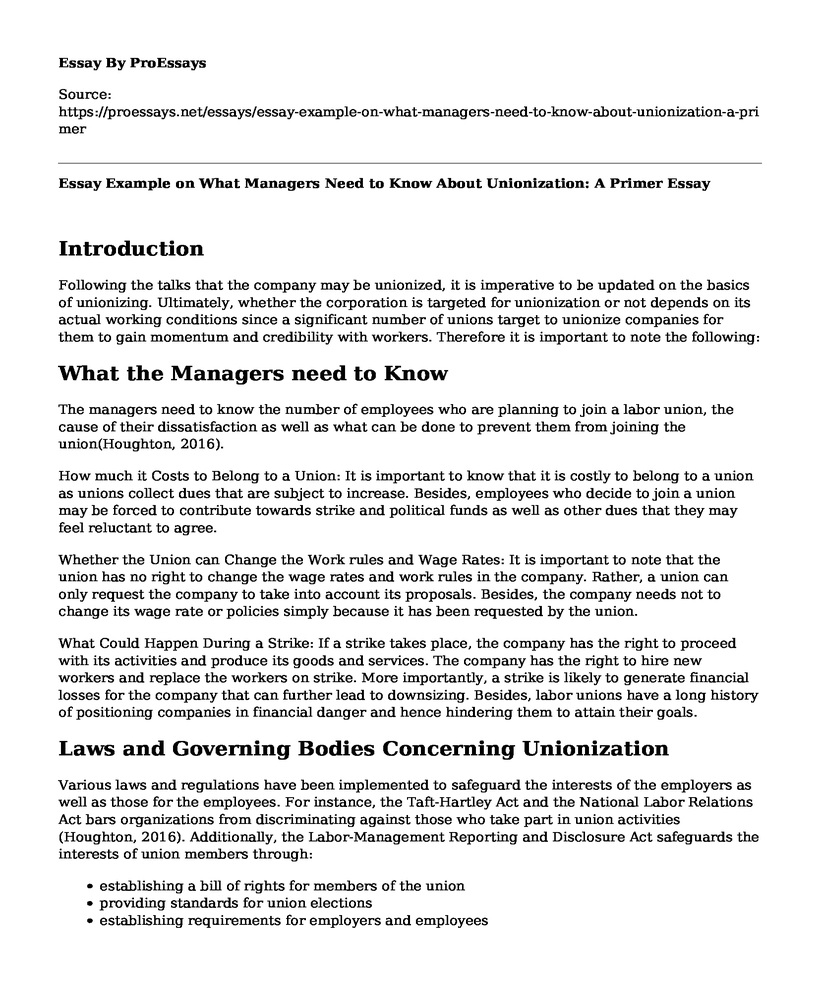Introduction
Following the talks that the company may be unionized, it is imperative to be updated on the basics of unionizing. Ultimately, whether the corporation is targeted for unionization or not depends on its actual working conditions since a significant number of unions target to unionize companies for them to gain momentum and credibility with workers. Therefore it is important to note the following:
What the Managers need to Know
The managers need to know the number of employees who are planning to join a labor union, the cause of their dissatisfaction as well as what can be done to prevent them from joining the union(Houghton, 2016).
How much it Costs to Belong to a Union: It is important to know that it is costly to belong to a union as unions collect dues that are subject to increase. Besides, employees who decide to join a union may be forced to contribute towards strike and political funds as well as other dues that they may feel reluctant to agree.
Whether the Union can Change the Work rules and Wage Rates: It is important to note that the union has no right to change the wage rates and work rules in the company. Rather, a union can only request the company to take into account its proposals. Besides, the company needs not to change its wage rate or policies simply because it has been requested by the union.
What Could Happen During a Strike: If a strike takes place, the company has the right to proceed with its activities and produce its goods and services. The company has the right to hire new workers and replace the workers on strike. More importantly, a strike is likely to generate financial losses for the company that can further lead to downsizing. Besides, labor unions have a long history of positioning companies in financial danger and hence hindering them to attain their goals.
Laws and Governing Bodies Concerning Unionization
Various laws and regulations have been implemented to safeguard the interests of the employers as well as those for the employees. For instance, the Taft-Hartley Act and the National Labor Relations Act bars organizations from discriminating against those who take part in union activities (Houghton, 2016). Additionally, the Labor-Management Reporting and Disclosure Act safeguards the interests of union members through:
- establishing a bill of rights for members of the union
- providing standards for union elections
- establishing requirements for employers and employees
workers are granted the right to join a union by the labor laws and regulations. If a company decides to run as a non-union, it has the right to persuade its workers not to be part of a union. Besides, the company can safeguard these rights by being cautious and monitoring its behavior.
The Dos and Don’ts Management should keep in Mind
The Don’ts
When there is a possibility of unionization in a given company, the management should keep in mind certain factors.
The management should not:
- engage in the investigation of the workers to find out their views concerning the union
- prematurely terminate employees’ contracts based on their support of the union
- discriminate against workers who choose to join the union
- question workers who anticipate joining the union just to get information on the union activities
- prevent employees to discuss their views of the union during breaks
- discourage workers to join the union by giving benefits like holidays and salary increase
The Dos
The management should conduct meetings with the workers during working hours and within the company premises to debate its position regarding unionization. Rather than inviting employees to the supervisors’ office, the discussions should be held at the employees’ workstations (Hertel-Fernandez et al., 2019).
In discussing the company’s take on unionization, the management should:
- describe the benefits that employees enjoy from the company like job security
- describe to the employees' terminologies like union shop and dues checkoff
- let the employees know how their wages will be affected and how they relate with both nonunionized and unionized corporations
- outline the cost of joining a union like strikes, fines, and payment of dues
- describe to the employees that they are free to join the union
- demonstrate their desire that the workers would reconsider to join the union
- illustrate the actuality about past relationships with a union
Conclusion
There is a chance that a union can give employees promises that it cannot deliver. Most labor unions are only concerned about winning the right to bargain with management to collect dues and no interests of the employees. The most significant benefit that the employees would gain from a union is the right to strike or negotiate.
References
Hertel-Fernandez, A., Kimball, W., & Kochan, T. (2019). How US Workers Think about Workplace Democracy: The Structure of Individual Worker Preferences for Labor Representation. Washington Center for Equitable Growth Working paper.
J. D. (2016). Extraversion and organizational work beliefs as pre-employment predictors of union attitudes. Journal of Behavioral and Applied Management, 1(2), 791.
file:///C:/Users/Feerot/AppData/Local/Temp/791-extraversion-and-organizational-work-beliefs-as-pre-employment-predictors-of-union-attitudes.pdf
Cite this page
Essay Example on What Managers Need to Know About Unionization: A Primer. (2023, Aug 12). Retrieved from https://proessays.net/essays/essay-example-on-what-managers-need-to-know-about-unionization-a-primer
If you are the original author of this essay and no longer wish to have it published on the ProEssays website, please click below to request its removal:
- Collaboration Leadership in Development of a Mental Health Care Agency
- Building and Maintaining Professional Relationships Essay
- Operational Management at Ford Paper Example
- Essay Sample on Organizational Design & Corporate Culture: The Invisible Codebook at Work
- Essay Example on Redesigning Healthcare Workflow for Improved Efficiency
- Managing Change: A Necessary Part of Life & Business - Essay Sample
- Strategies and Steps in Database Security - Paper Example







